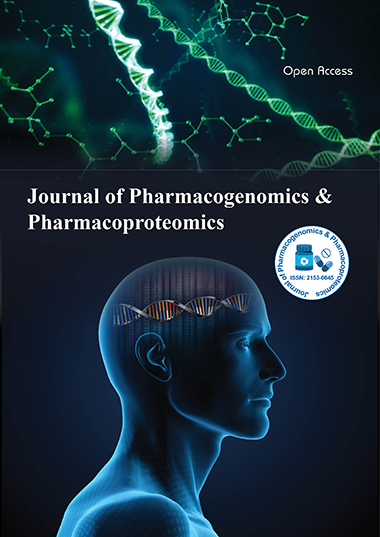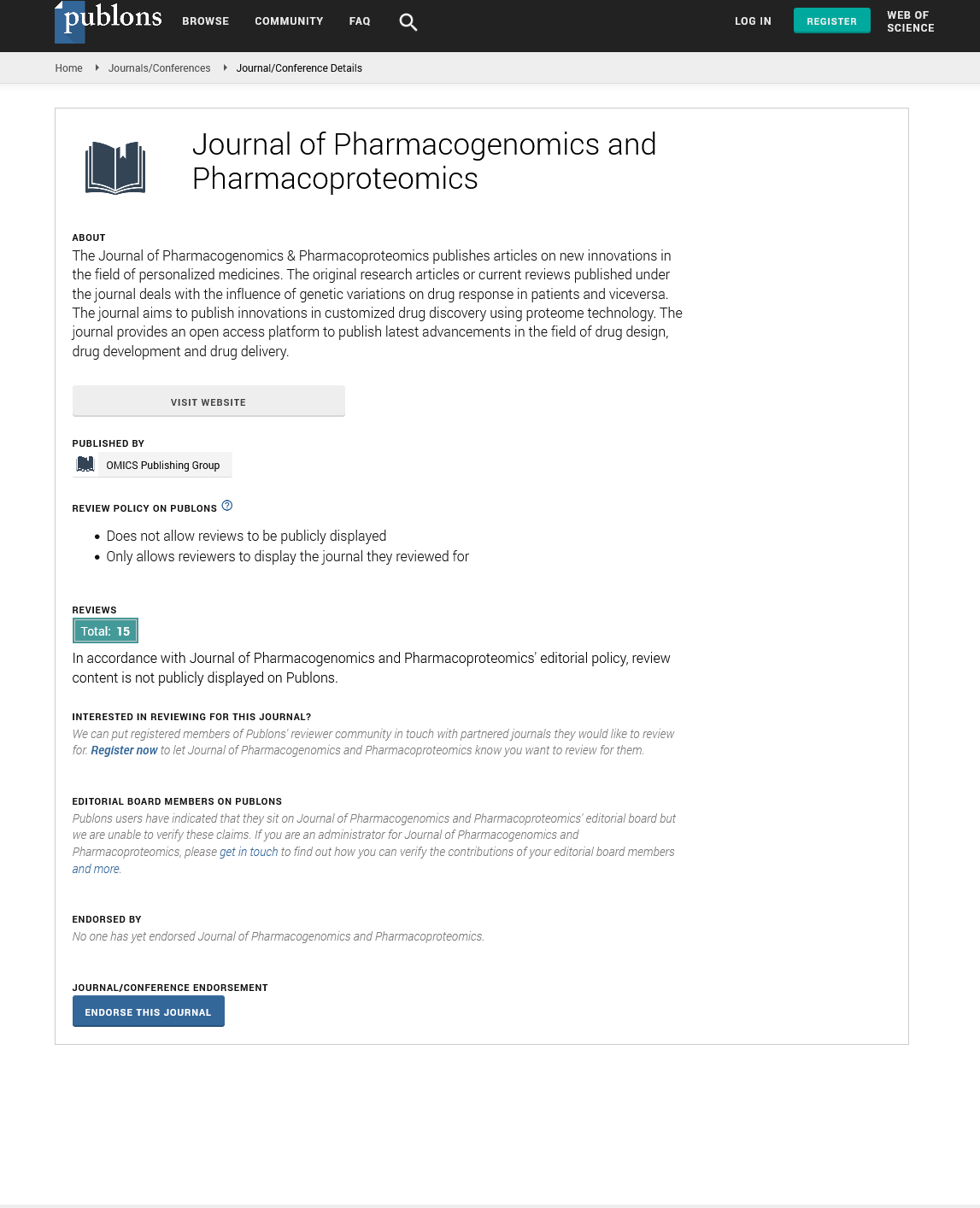Indexed In
- Open J Gate
- Genamics JournalSeek
- Academic Keys
- JournalTOCs
- ResearchBible
- Electronic Journals Library
- RefSeek
- Hamdard University
- EBSCO A-Z
- OCLC- WorldCat
- Proquest Summons
- SWB online catalog
- Virtual Library of Biology (vifabio)
- Publons
- MIAR
- Euro Pub
- Google Scholar
Useful Links
Share This Page
Journal Flyer

Open Access Journals
- Agri and Aquaculture
- Biochemistry
- Bioinformatics & Systems Biology
- Business & Management
- Chemistry
- Clinical Sciences
- Engineering
- Food & Nutrition
- General Science
- Genetics & Molecular Biology
- Immunology & Microbiology
- Medical Sciences
- Neuroscience & Psychology
- Nursing & Health Care
- Pharmaceutical Sciences
Perspective - (2024) Volume 15, Issue 4
Human Cancer Stem Cells in Predicting Efficacy and Toxicity of Chemotherapeutic Drugs for Cancer-Specific DNA Damage
Received: 25-Nov-2024, Manuscript No. JPP-24-27921; Editor assigned: 29-Nov-2024, Pre QC No. JPP-24-27921 (PQ); Reviewed: 16-Dec-2024, QC No. JPP-24-27921; Revised: 24-Dec-2024, Manuscript No. JPP-24-27921 (R); Published: 31-Dec-2024, DOI: 10.35248/2153-0645.24.15.117
Description
Cancer is a complex and heterogeneous disease that continues to challenge conventional treatment strategies. Traditional cancer therapies, including chemotherapy, have been effective in treating a wide range of cancers; however, the problem of drug resistance, relapse and toxicity remains prevalent. One of the key factors contributing to these challenges is the presence of Cancer Stem Cells (CSCs), a subpopulation of tumor cells with stem-like properties that have been implicated in tumor initiation, progression and resistance to treatment. As a result, there has been increasing interest in understanding how CSCs can be utilized to predict the efficacy and toxicity of chemotherapeutic drugs, particularly those that induce cancer-specific DNA damage.
This manuscript explores the role of human cancer stem cells in predicting the response to chemotherapy, focusing on their ability to identify drug efficacy, toxicity and the mechanisms by which chemotherapeutic agents induce DNA damage in cancer cells. Understanding Cancer Stem Cells (CSCs) are a small fraction of cells within a tumor that possess the ability to self renew, differentiate into various tumor cell types and regenerate the entire tumor. These cells exhibit properties similar to normal stem cells, including the expression of certain stem cell markers such as CD44, CD133 and ALDH. CSCs are thought to be responsible for tumor initiation and recurrence, as they are capable of surviving chemotherapy and radiotherapy, which typically target rapidly proliferating cells, not the more quiescent and resistant CSCs. Consequently, targeting CSCs has become a promising strategy in cancer treatment to improve patient outcomes and prevent relapse. CSCs are also characterized by their ability to evade the immune system, their resistance to chemotherapy-induced cell death and their capacity to repair DNA damage more efficiently than non-CSC tumor cells. This makes them a critical target in predicting the success or failure of cancer treatments, especially chemotherapeutic agents that induce DNA damage.
Chemotherapy drugs are designed to kill rapidly dividing cells by inducing DNA damage. These agents typically function by targeting specific pathways involved in cell replication, including DNA synthesis and repair. However, CSCs are often more resistant to these drugs due to their quiescence, enhanced DNA repair mechanisms and the presence of anti-apoptotic proteins. CSCs often express high levels of DNA repair enzymes, such as Poly (ADP-Ribose) Polymerase (PARP), which allow them to repair DNA damage induced by chemotherapy. As a result, while conventional cancer cells may undergo apoptosis after chemotherapy-induced DNA damage, CSCs can survive, proliferate and contribute to tumor regrowth. Moreover, the metabolic state of CSCs can influence their response to chemotherapy. CSCs have been shown to possess altered metabolic processes, including increased glycolysis (Warburg effect), which may confer an advantage in surviving chemotherapy-induced DNA damage. These metabolic differences are critical in the development of new therapeutic strategies aimed at targeting CSCs and improving the efficacy of chemotherapy.
Chemotherapy drugs induce DNA damage by interfering with various stages of the cell cycle, preventing DNA replication and activating cell death pathways. DNA Strand Breaks: Some chemotherapy drugs, such as topoisomerase inhibitors, cause double-strand breaks in the DNA. These breaks are particularly lethal to cells during DNA replication. For example, topoisomerase II inhibitors like doxorubicin inhibit the enzyme topoisomerase II, leading to DNA double-strand breaks that cannot be repaired efficiently by CSCs. DNA Cross-Linking: Alkylating agents, such as cyclophosphamide, cause DNA cross-linking, preventing DNA strands from separating during replication. These agents are potent DNA-damaging drugs and have been used for various cancers, including breast cancer and leukemia. Inhibition of DNA Repair Mechanisms: Some chemotherapeutic agents work by inhibiting the cell's ability to repair DNA damage. For example, PARP inhibitors prevent the repair of single-strand DNA breaks, leading to the accumulation of DNA damage and cell death. Cancer cells, including CSCs, rely heavily on DNA repair mechanisms to survive chemotherapy and inhibitors of these processes could enhance the efficacy of chemotherapy by preventing CSCs from repairing DNA damage.
Some chemotherapy drugs induce replication stress, causing DNA damage during the replication process. These drugs affect the integrity of the replication machinery, leading to stalled replication forks and DNA breaks. Replication stress is particularly detrimental to CSCs, as their DNA repair mechanisms are often more robust, allowing them to cope with the damage more efficiently than differentiated tumor cells. Human cancer stem cells play a essential role in predicting the efficacy and toxicity of chemotherapeutic drugs. Their unique characteristics make them an ideal model for testing cancer therapies and understanding how drugs induce DNA damage. The response of CSCs to chemotherapy can be an indicator of how effective a drug will be in treating the entire tumor. Since CSCs are thought to be responsible for tumor initiation, maintenance and relapse, their response to DNA-damaging agents is an important factor in determining the overall efficacy of chemotherapy. If a drug can effectively target and eliminate CSCs, it is likely to result in a more durable response and reduced risk of relapse. CSC-based assays, such as sphere formation assays, can be used to evaluate the ability of chemotherapeutic drugs to target and kill CSCs, providing insights into the drug's potential efficacy.
Citation: Chunyu M (2024). Human Cancer Stem Cells in Predicting Efficacy and Toxicity of Chemotherapeutic Drugs for Cancer-Specific DNA Damage. J Pharmacogenom Pharmacoproteomics. 15:117.
Copyright: © 2024 Chunyu M. This is an open-access article distributed under the terms of the Creative Commons Attribution License, which permits unrestricted use, distribution, and reproduction in any medium, provided the original author and source are credited.

